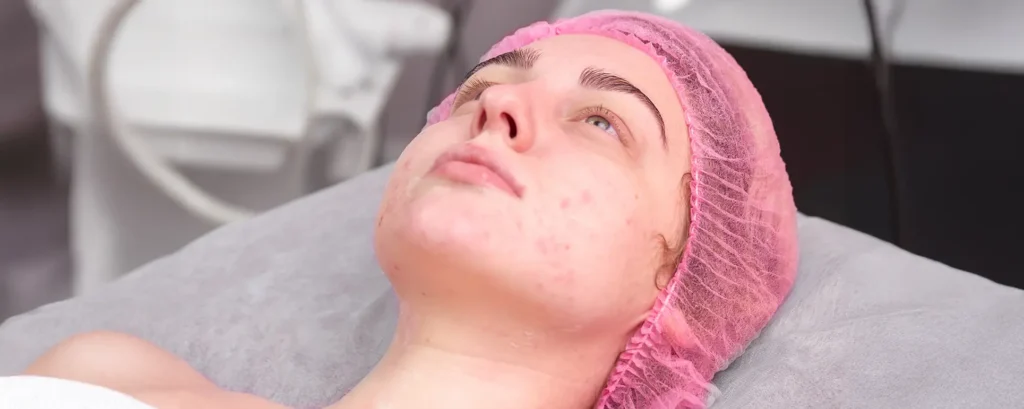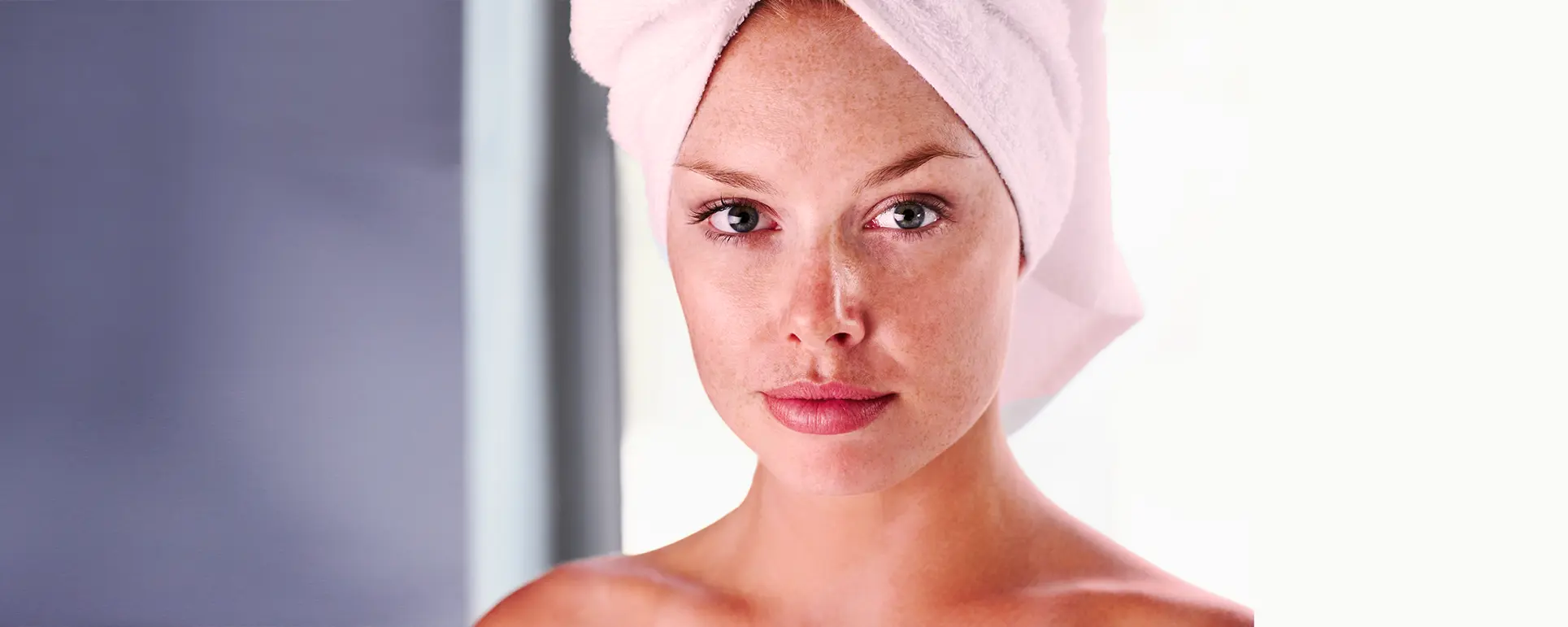If your skin often turns red or flushed after a shower, you’re not alone. Many people experience temporary redness after bathing, especially if they prefer hot water or have sensitive skin. But when should you be concerned and what can you do to stop it?
In most cases, red skin after showering is harmless and simply your body reacting to heat, water pressure, or dryness. However, persistent or painful redness can sometimes point to an underlying skin condition, such as rosacea or eczema.
In this guide, we’ll look at the most common reasons for post-shower redness, when it’s perfectly normal, and when you should speak to a dermatologist for further advice.
Why Does Skin Turn Red After a Shower?
When you step into a warm shower, your blood vessels naturally expand a process known as vasodilation. This increases blood flow near the surface of your skin, giving it that flushed or pinkish tone.
This response is completely normal and usually subsides within minutes of drying off. However, several other factors can contribute to or exaggerate redness. Let’s go through them one by one.
1. Hot Water
The number one culprit behind red skin after showering is simple: the water is too hot.
Hot water strips away your skin’s natural oils, disrupting its protective barrier. This can lead to dryness, irritation, and inflammation all of which make your skin appear red.
What you can do:
- Lower the temperature to lukewarm.
- Limit showers to 5–10 minutes.
- Moisturise immediately afterwards to lock in hydration.
If your skin feels tight or itchy after every shower, it’s a clear sign that the water is too hot.
2. Sensitive or Reactive Skin
If you have naturally sensitive skin, even mild heat or friction from a towel can cause temporary redness.
People with conditions like rosacea, eczema, or contact dermatitis often find that showers aggravate their symptoms. Fragranced shower gels and body washes can also make the problem worse.
Tips for sensitive skin:
- Choose fragrance-free and hypoallergenic products.
- Avoid loofahs or harsh sponges.
- Pat dry gently instead of rubbing.
If sensitivity persists, a dermatologist can recommend suitable skincare or prescribe treatments to strengthen your skin barrier.
3. Rosacea

Rosacea is a chronic skin condition that causes facial redness, flushing, and visible blood vessels. Hot showers are a well-known trigger for flare-ups.
When exposed to heat, rosacea-prone skin reacts more strongly than usual, leading to prolonged redness, burning, and sometimes bumps.
What helps:
- Use cool or lukewarm water on your face.
- Avoid washing your face in the shower altogether instead, cleanse at the sink with cooler water.
- Avoid alcohol-based cleansers and exfoliants.
If your facial redness lasts for hours or includes visible veins, it’s best to speak to a dermatologist for a proper diagnosis.
4. Dry Skin (Xerosis)
Dry skin is another common reason for redness after a shower.
When your skin lacks moisture, exposure to water especially hot water can temporarily inflame it, leading to blotchy patches and discomfort.
What you can do:
- Switch to a mild, soap-free cleanser.
- Apply a rich, fragrance-free moisturiser immediately after showering while your skin is still slightly damp.
- Avoid long or frequent showers.
Consistency is key. Over time, a stronger moisture barrier will make your skin less reactive.
5. Hard Water
The minerals in hard water particularly calcium and magnesium can disrupt your skin’s natural pH balance. This can leave your skin feeling dry, tight, and red after every shower.
If your area has hard water, you might notice soap scum on tiles or a filmy residue on your skin.
Possible solutions:
- Install a water softener or shower filter.
- Rinse your skin with purified or bottled water if irritation is severe.
- Use moisturisers containing ceramides to restore balance.
A dermatologist can also advise if hard water might be aggravating your symptoms.
6. Heat Rash
If your bathroom is particularly hot and humid, a heat rash (miliaria) can develop. It happens when sweat glands become blocked, trapping sweat beneath the skin.
Symptoms include small, itchy red bumps or prickly sensations that appear shortly after showering.
What helps:
- Keep the bathroom well ventilated.
- Avoid very hot showers.
- Apply a cool compress to calm irritation.
This type of redness usually settles quickly once your skin cools down.
7. Allergic Reactions
Sometimes, the cause of redness isn’t heat it’s an ingredient in your products. Shower gels, shampoos, or conditioners containing strong fragrances, preservatives, or sulphates can cause contact dermatitis.
You might notice:
- Red, inflamed patches after each shower.
- Itchiness or mild burning sensations.
- Rashes where products run down your body.
To manage:
- Switch to gentle, fragrance-free formulas.
- Avoid “antibacterial” or heavily perfumed soaps.
- See a dermatologist for patch testing if you suspect an allergy.
8. Scrubbing or Over-Exfoliating
Excessive scrubbing can leave your skin red and irritated, especially if you use rough sponges or exfoliating body washes.
Your skin’s surface barrier needs to stay intact to protect against dryness and bacteria. Over-exfoliating can strip it, leaving your skin inflamed and more reactive to water.
Better habits:
- Exfoliate gently once or twice a week only.
- Use soft washcloths instead of loofahs.
- Moisturise generously afterwards.
9. Blood Flow and Flushing
In some people, redness after showering is due to blood flow changes rather than irritation. Warm water increases circulation, which can cause a temporary flush that fades as your body cools.
This type of redness is harmless and doesn’t need treatment unless accompanied by other symptoms like itching or pain.
10. Underlying Skin Conditions
Persistent or patchy redness that doesn’t fade after showering could be a sign of a skin condition such as:
- Eczema: Causes itchy, dry, and red patches.
- Psoriasis: Triggers thicker, scaly red plaques.
- Seborrhoeic dermatitis: Affects areas like the scalp, eyebrows, and sides of the nose.
If your redness is recurring or comes with other symptoms, book a consultation with a dermatologist for a thorough assessment.
When Is Redness After Showering Harmless?

In most cases, red skin after showering is completely normal and short-lived. It’s simply your body responding to temperature changes and increased circulation.
Harmless redness usually:
- Fades within 10–15 minutes.
- Doesn’t itch or burn.
- Doesn’t cause dryness or flaking.
If your skin looks and feels normal soon after drying off, there’s little reason to worry.
When to Be Concerned
You should speak to a dermatologist if:
- Redness lasts longer than 30 minutes after showering.
- Your skin feels painful, tight, or inflamed.
- You experience itching, burning, or rashes regularly.
- You’ve developed new sensitivity to your usual products.
These could be signs of rosacea, eczema, or contact dermatitis that need professional care.
Dermatologist-Approved Tips to Prevent Redness
If you’re tired of dealing with redness after showers, these simple adjustments can help:
- Use lukewarm water. Keep it comfortable not steaming.
- Shorten your showers. Stick to 10 minutes or less.
- Moisturise immediately. Apply emollient cream or body oil while your skin is still slightly damp.
- Switch to gentle cleansers. Look for products labelled “fragrance-free” or “for sensitive skin.”
- Avoid alcohol-based products. These dry out the skin quickly.
- Wear soft, breathable fabrics. Cotton towels are kinder than rough microfibre.
- Rinse off thoroughly. Make sure no soap or shampoo residue remains.
Following these steps helps strengthen your skin barrier, so it reacts less to everyday triggers.
Skincare Ingredients That Help Calm Redness
If you notice your skin looks red or feels sensitive after a shower, there are some ingredients you can look for in your skincare to help calm and soothe it. Choosing the right products can make a big difference in how quickly your skin recovers and feels comfortable again.
- Ceramides: These help strengthen your skin’s natural barrier, so it’s better able to protect itself from irritation. By reinforcing this barrier, your skin can retain moisture more effectively, which is essential for reducing redness and preventing flare-ups.
- Aloe vera: A classic go-to for a reason it cools and hydrates your skin, giving almost instant relief from heat, stinging, or visible redness. You might notice your skin feels softer and calmer after applying a thin layer.
- Niacinamide: This multitasking ingredient reduces inflammation and helps even out your skin tone, making redness appear less noticeable over time. Many people find that incorporating niacinamide into their routine not only calms irritation but also helps improve overall skin texture.
- Colloidal oatmeal: Ideal for sensitive or itchy skin, this ingredient gently soothes and calms irritation. You can find it in moisturisers, masks, or even body washes, making it easy to include in your routine after showers.
- Panthenol (vitamin B5): Known for its moisture-retaining and healing properties, panthenol helps your skin feel soft and comfortable while supporting recovery from irritation or dryness.
While you’re focusing on calming your skin, it’s best to avoid harsh acids, strong exfoliants, or scrubs until your redness has fully settled. These can aggravate irritation and slow down your skin’s recovery. Instead, stick to gentle, hydrating products that support your skin’s barrier. Layering a soothing cleanser, followed by a lightweight serum with niacinamide or panthenol, and finishing with a ceramide-rich moisturiser can help maximise relief and keep your skin feeling balanced.
By giving your skin this extra care and attention, you’re not just reducing redness in the moment you’re also helping it stay stronger and healthier long-term. With consistent use, you may notice that flare-ups become less frequent and your skin feels calmer even after workouts or evening showers.
Can Shower Frequency Affect Skin Redness?
If you’ve just finished a workout, taking a shower is important for hygiene and comfort. However, sweat, heat, and increased blood flow can make your skin more sensitive or reactive right after exercise. To help prevent extra redness or irritation, take a few minutes to cool down before you hop into the shower. Once you’re ready, stick to lukewarm water rather than hot water, as very hot showers can strip your skin of its natural oils and worsen flushing.
For your evening shower, you can take a few extra steps to soothe your skin. Try finishing with a quick splash of cool water just before stepping out. This simple trick helps constrict your blood vessels, calming redness and giving your skin a more even tone. You might also notice that this helps you feel refreshed and relaxed before bed, which is a nice bonus after a long day.
You can also be mindful of the products you use during these showers. Gentle, fragrance-free cleansers or body washes are usually better for sensitive skin, while harsh soaps or scrubs can aggravate irritation. After showering, pat your skin dry instead of rubbing it, and follow up with a light, soothing moisturizer. Doing this consistently can help protect your skin’s barrier and keep redness or flare-ups to a minimum, even after intense workouts or late-night showers.
What About After-Gym or Evening Showers?
Post-workout showers are essential for hygiene, but sweat and heat can already make your skin more reactive. Always cool down first, and then opt for a lukewarm shower to avoid compounding redness.
For evening showers, finish with a quick splash of cool water before stepping out this helps constrict blood vessels and reduce flushing.
FAQs:
1. Why does my skin turn red immediately after a shower?
Your skin turns red after showering because of a natural process called vasodilation. When warm water touches your skin, the blood vessels near the surface expand, increasing blood flow. This gives your skin that flushed, pinkish appearance. In most people, this redness is temporary and usually fades within a few minutes. It’s a normal reaction and doesn’t mean your skin is damaged. However, if your skin feels itchy, painful, or the redness lingers, it might be a sign of sensitive skin or an underlying condition like rosacea or eczema.
2. Can shower temperature really affect redness?
Yes, the temperature of your shower plays a big role in how your skin reacts. Hot water can strip your skin of its natural oils, weakening its protective barrier. This can make redness worse and sometimes leave your skin feeling tight, dry, or inflamed. Lukewarm showers are much gentler, helping your skin retain moisture and stay balanced. Over time, keeping your showers comfortably warm rather than hot can significantly reduce post-shower redness.
3. Does sensitive skin make me more prone to redness?
If you have sensitive or reactive skin, you may notice that your skin flushes easily, even with mild heat or friction from a towel. Skin conditions like rosacea, eczema, or contact dermatitis can also make your skin react more strongly. Certain shower products, especially those with fragrances or harsh chemicals, can aggravate sensitive skin and prolong redness. Choosing gentle, hypoallergenic products and patting your skin dry rather than rubbing can make a big difference.
4. Is facial redness after showering always rosacea?
Not necessarily. While rosacea can cause prolonged facial redness, flushing, and visible blood vessels, occasional redness after a shower doesn’t always indicate this condition. Many people experience temporary redness from warm water, increased circulation, or irritation. You might want to speak to a dermatologist if the redness lasts for hours, is accompanied by bumps or burning, or appears frequently, as they can provide a proper diagnosis and recommend treatments tailored to your skin.
5. Can dryness make redness worse?
Absolutely. When your skin is dry, it loses its ability to retain moisture and defend against irritants. Exposure to water, especially hot water, can inflame dry skin, causing blotchy or red patches. Consistently using a gentle, soap-free cleanser and applying a rich, fragrance-free moisturizer immediately after showering can help restore hydration and strengthen your skin’s barrier. Over time, this makes your skin less reactive to everyday triggers.
6. Does hard water contribute to redness?
Yes, hard water contains high levels of minerals like calcium and magnesium, which can disrupt your skin’s natural pH balance. This can leave your skin feeling tight, dry, and more prone to redness after every shower. People living in areas with hard water sometimes notice soap residue or a filmy feeling on their skin. Installing a shower filter or using moisturizers with barrier-supporting ingredients such as ceramides can help reduce irritation caused by hard water.
7. Are there habits during showering that make redness worse?
Scrubbing too hard, over-exfoliating, or using rough sponges can damage your skin’s surface barrier. This leaves your skin inflamed, more reactive, and prone to redness. Even rubbing your skin vigorously with a towel can intensify flushing. Gentle, minimal exfoliation and patting your skin dry can help keep your skin calm. Additionally, avoiding long showers in hot, steamy bathrooms can prevent heat-related redness or even mild heat rash.
8. Can shower frequency affect my skin’s redness?
Yes, how often you shower can influence your skin’s reaction. Frequent showers, especially with hot water or harsh cleansers, can strip your skin of natural oils and weaken its barrier, making it more reactive and prone to redness. On the other hand, skipping showers entirely can allow sweat, oils, and bacteria to accumulate, which can also irritate the skin. Finding a balance and using gentle products is key to keeping your skin healthy and minimizing redness.
9. When should I see a dermatologist about redness after showering?
You should consider booking a consultation if redness persists for more than 30 minutes, is painful, or is accompanied by itching, burning, or rashes. Sudden changes in how your skin reacts to products or water temperature may also warrant professional advice. A dermatologist can identify conditions such as rosacea, eczema, psoriasis, or contact dermatitis, and recommend treatments or skincare routines to calm your skin and prevent flare-ups.
10. Can skincare help reduce redness after showers?
Yes, the right skincare can make a noticeable difference. Ingredients like ceramides, niacinamide, aloe vera, colloidal oatmeal, and panthenol help calm irritation, strengthen the skin barrier, and retain moisture. Applying gentle, hydrating products immediately after a shower can reduce redness and protect your skin from recurring flare-ups. Consistent use of these soothing ingredients supports long-term skin health, so redness becomes less frequent even after workouts or evening showers.
Final Thoughts: Managing Redness After Showering
Experiencing red or flushed skin after a shower can be common, but consistent or prolonged redness may indicate an underlying skin condition. Simple adjustments, like using lukewarm water, gentle cleansers, and moisturising immediately, can help reduce irritation and protect your skin’s barrier. If redness persists, is painful, or comes with other symptoms, it’s best to seek professional guidance.
You can book a consultation with one of our dermatologists by contacting us at the London Dermatology Centre. Our dermatologist will assess your skin, identify potential causes such as rosacea, eczema, or sensitivity, and recommend a personalised routine or treatment plan to calm your skin and prevent future flare-ups. With the right care, you can help your skin stay healthy, balanced, and comfortable after every shower.
References:
1. Rastogi, V. (2018). Flushing disorders associated with gastrointestinal and other systemic diseases. Journal of Clinical Gastroenterology, 52(4), 297–305. Available at: https://pmc.ncbi.nlm.nih.gov/articles/PMC6108508/
2. Gade, A. (2023). Xeroderma. In: StatPearls [Internet]. Treasure Island (FL): StatPearls Publishing. Available at: https://www.ncbi.nlm.nih.gov/books/NBK565884/
3. O’Connor, C., et al. (2023). Pooling the evidence: A review of swimming and atopic dermatitis. Journal of Dermatological Treatment, 34(5), 1–8. Available at: https://pmc.ncbi.nlm.nih.gov/articles/PMC10946598/
4. Guerra, K.C. (2024). Miliaria. In: StatPearls [Internet]. Treasure Island (FL): StatPearls Publishing. Available at: https://www.ncbi.nlm.nih.gov/books/NBK537176/
5. Hannuksela, M. & Väänänen, A. (1988). The sauna, skin and skin diseases. Acta Dermato-Venereologica, 68(6), 481–485. Available at: https://pubmed.ncbi.nlm.nih.gov/3218900/
